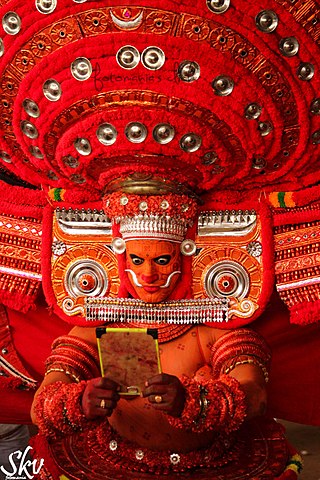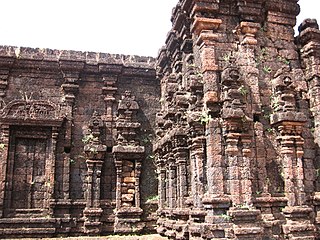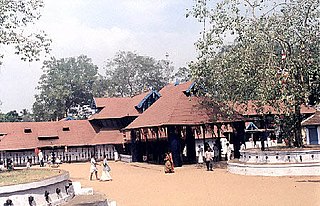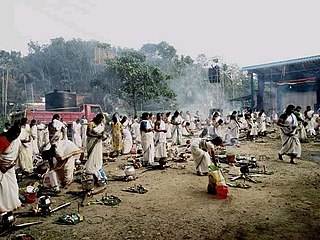
Theyyam is a Hindu religious ritual practiced in northern Kerala and some parts of Karnataka. Theyyam is also known as Kaḷiyāṭṭaṁ or Tiṟa. Theyyam consists of traditions, rituals and customs associated with temples and sacred groves of Malabar. The people of the region consider Theyyam itself as a channel to a god and they thus seek blessings from Theyyam.

The ChottanikkaraDevi Temple is a temple dedicated to the Hindu mother goddess Bhagavati Lakshmi. She is believed to be residing in Chottanikkara (Mahalakshmi) along with her Husband Maha Vishnu. The main deity is also considered as Lakshmi Narayana according to the temple legend. The temple is Classified one among the 108 Abhimana Kshethram of Vaishnavate tradition. The temple is located at Chottanikkara, a southern suburb of the city of Kochi in Ernakulam district, in the state of Kerala, India and is one of the most popular temples in the state. The temple is also known for conducting exorcism.

The Rajarajeshwara temple is a Shiva temple located in Taliparamba in Kannur district of Kerala State of India. The temple is regarded as one of the existing 108 ancient Shiva Temples of ancient Kerala. It also has a prominent place amongst the numerous Shiva temples in South India. It had the tallest shikhara amongst the temples of its time. The Rajarajeshwara temple has a top of about 90 tonnes. If any problem is encountered in the other temples of South India, devotees seek a solution in this temple through a prashnam, a traditional method of astrological decision-making. The prashnam is conducted on a peedha outside the temple.
Azhakodi Devi Temple or Azhakodi Devi Mahakshethram is a Hindu temple located in Thiruthiyad, Kozhikode District, Kerala, South India. It is one of the famous Devi temples, situated hardly 1.5 km away from the Mofussil Bus stand and 2.5 km from the KSRTC Bus stand, the area still retains the beauty and charm of un-spoilt rural settings within the heart of the Kozhikode city. The temple and the Kalayana Mandapom are administered by the Malabar Devaswom Board.

Bhadrakali is a Hindu goddess. She is considered to be the auspicious and fortunate form of Adi Shakti who protects the good, known as bhadra.

Govindapuram is a small suburb of Kozhikode (Calicut) city in the Kozhikode District of Kerala, India. Govindapuram is a small corporation block that comes under Calicut corporation.

Manapullikavu is a Hindu temple dedicated to Mother Goddess, situated in Palakkad city, Kerala, India. Manapullikavu Vela is an annual festival that takes place in the temple. It is organised by 8 sets of commities or deshams. Elephants and fireworks are the highlights of the festival.

Bhagavatī, is an Indian epithet of Sanskrit origin, used as an honorific title for goddesses in Hinduism and Buddhism. In Hinduism, it is primarily used to address the goddesses Durga and Lakshmi. In Buddhism, it is used to refer to several Mahayana Buddhist female deities, like Cundā.

Thirumandhamkunnu Temple is a historically significant Hindu temple in Angadipuram, which was the capital of Valluvanad Rajavamsham, in Malappuram district, Kerala state, South India. The temple deity, Thirumandhamkunnil amma, was the paradevatha of the kings of Valluvanad, the local feudal kings ruled the area in the Middle Ages. The Nair warriors of Valluvanad king set out from this temple to Thirunavaya, to participate in the famous Mamankam festival. A memorial structure called the chaver thara can be found in front of the main entrance of the Thirumanthamkunnu Temple.

The Vilwadrinatha Temple is a Hindu temple in Thiruvilwamala, a town in the city of Thrissur, Kerala, India. The principal deities are Rama, the seventh incarnation of the god Vishnu, and his brother, Lakshmana. It figures among the Abhimana Kshetrams in Vaishnavite traditions. This is one of the four major Rama temples in Kerala — the other three are in Thriprayar, Kadavallur, and Thiruvangad. The temple houses an idol of Lakshmana, which is rare in India. Vilwadrinatha Temple is located in the centre of the community of Thiruvilwamala, atop a 100-foot-high hillock. Visible from the temple is Bharathappuzha, the second-largest river in Kerala, which flows past the temple's northern side from around 3 kilometres away.
Chakkulathukavu Temple is a Hindu temple dedicated to the goddess Durga. Situated near Thiruvalla in Neerattupuram, Thalavady Panchayat, Alappuzha District, Kerala, India, it is one of the most renowned temples in the state.

Mankavu is a suburb of Kozhikode, in Kerala, India. It is known as the site of the Zamorin's kovilakam and it is called Mankavu Padinhare Kovilakam. Mankavu derives its name from the Zamorin's Mango Orchard that was in the area some historic records says that earlier was known as "Manavikraman kavu" and got shortened into "Mankave". The community is primarily residential, and is a common residential location for students from the local Zamorin's Guruvayurappan College. Krishna Varma and Ravi Varma, famous rebels of Calicut were born and brought up in Mankavu.

Thiruvarkadu Bhagavathi Temple is the mother temple of all Bhadrakali shrines of Kerala. The deity is the Fierce form of Bhadrakali. The Bhagavathy is addressed by tantrics in the vicinity as Tiruvarkkad Achchi due to this. The temple administration is Malabar Devaswom Board. The temple is a revered shrine of Chirakkal Royal Family and a shrine of Chirakkal devaswom before. The temple is situated in Madayi, Payangadi, hence prominently known as Madayi Kavu.
There are places of worship considered important in the Kannur district. Kannur District is one of the 14 districts in the state of Kerala, India. The town of Kannur is the district headquarters, and gives the district its name.

Sree Kurumba Bhagavati Temple is a Hindu temple at Kodungallur, Thrissur District, Kerala state, India. It is dedicated to the goddess Bhadrakali, a form of Mahakali or simply Durga or Aadi Parashakthi worshipped and significantly revered in Kerala. The goddess is known also by the names "Sri Kurumba"". This temple is the head of 64 Bhadrakali temples in Kerala. This Mahakali temple is one of the oldest functioning temples in India. The goddess of the temple represents the goddess in her fierce ('ugra') form, facing North, featuring eight hands with various attributes. One is holding the head of the demon king Daruka, another a sickle-shaped sword, next an anklet, another a bell, among others. Routine worship at the temple every day at 03:00 and ends at 21:00 local time.

Pongala is a harvest festival of Kerala and Tamil Nadu. The name 'Pongala' means 'to boil over' and refers to the ritualistic offering of porridge made of rice, sweet brown molasses, coconut gratings, nuts and raisins. Generally women devotees participate in this ritual. Tamil people celebrate as Pongal.

The MajorVellayani Devi Temple is a highly revered shrine in Kerala, India, dedicated to goddess Bhadrakali. The shrine is situated in Vellayani 1.5 km west of Vellayani junction, 12 km southeast of Thiruvananthapuram on the eastern bank of Vellayani Lake. The temple is under the management of Travancore Devaswom Board. The temple structure has a bronze roof with traditional art work and carries Dravidian architecture. The temple has eastern and northern towers called Gopurams with statues of different Gods sculptured in them. The Gopurams function as gateways through the walls that surround the temple complex.

Kalarivathukkal Bhagavathy Temple, Bhadrakali Shrine located near Valapattanam river, is the family shrine of Chirakkal Royal Family. The deity of the shrine is the fierce form of Bhadrakali. Kalarivathukkal Bhagavathy is considered as the mother of the ancient martial art Kalarippayattu and hence the name. The shrine is administered by Malabar Devaswom Board and classified as Category A Temple of the board. Kalarivathukkal has come from the word Kalari Vaatilkal.
Kaviyoor is a village located in Thiruvalla Sub-District & Taluk In Pathanamthitta district of Kerala State,India, situated on the western bank of the Manimala River.It Is Located Adjoining Thiruvalla Municipal Town.

Tali Shiva Temple or Tali Mahakshetram is a Hindu temple dedicated to the deity Shiva, situated in the heart of the Kozhikode city, Kerala. The temple was built in the 14th century by Zamorin of Calicut. Tali Kshetram is an ancient temple in the heart of Kozhikode town. Shiva is the presiding deity. The Jyothirlingam in the Sanctum Sanctorum is believed to have been installed by Parasuraman. The temple is one km to the east of Kozhikode railway station. It is surrounded by the Palayam market. This was the family temple of the Zamorins who had ruled Kozhikode. Although the temple is now under Malabar Devaswom, the Zamorin is the managing trustee. The temple is built in traditional Kerala architectural style. The two-storied sanctum-sanctorum is in the shape of a chariot. It is adorned with murals and granite sculptures of Shiva’s retinue. Inside Sree Kovil deities of Tali Ganapathy, Thevarathil Ganapathy and Thrumandhakunnu Bhagavathy are installed. Sree Krishna, Thevarathil Bhagavathy, Ayyappa, Sri Vishnu and Nagam are installed outside Shiva Temple. Sree Valayanad Bhagavati idol is installed inside Sree Krishna Temple. There is a small Narasimha Moorthy temple on the southern side of the Sri Vishnu Temple.


















